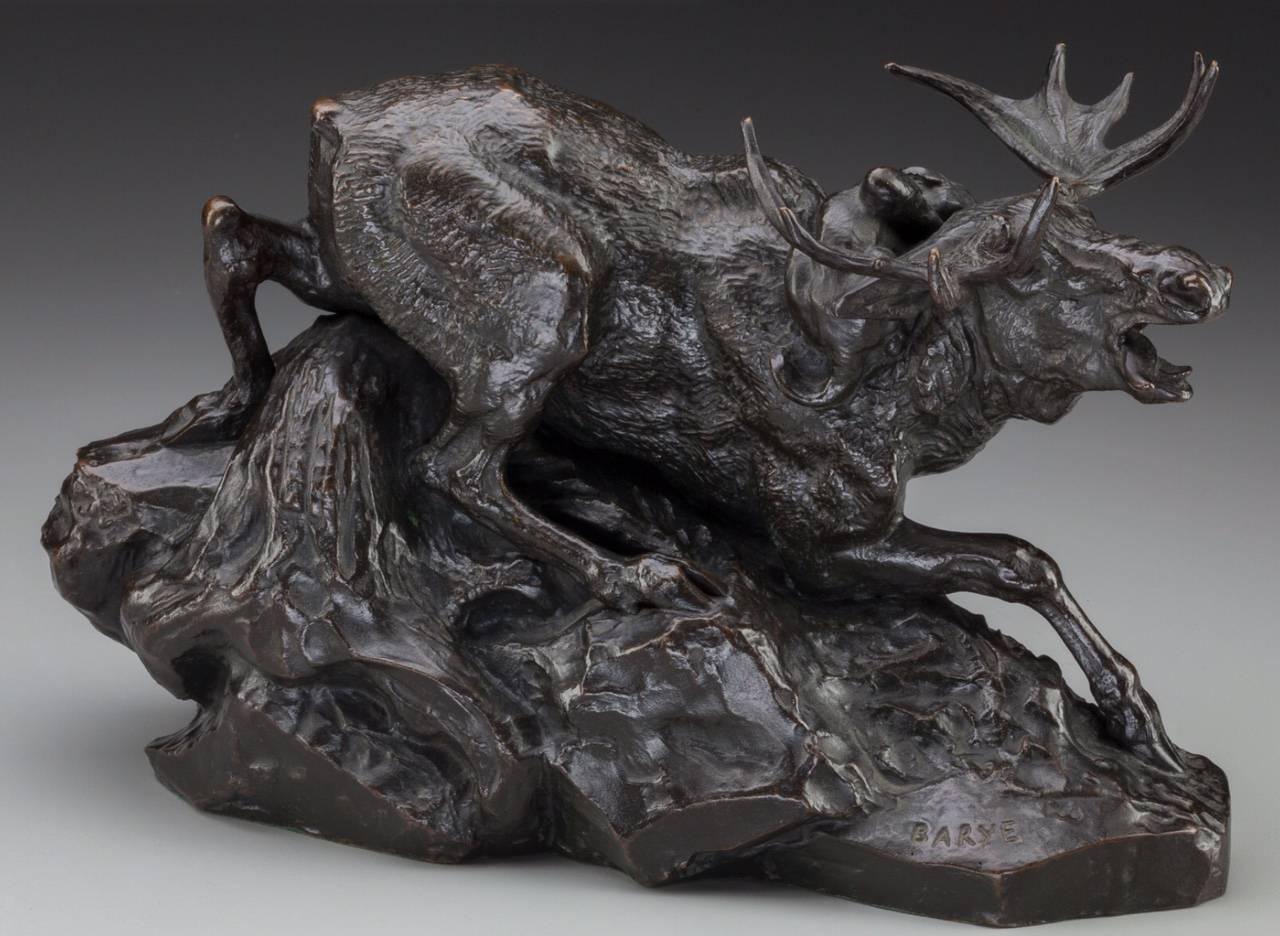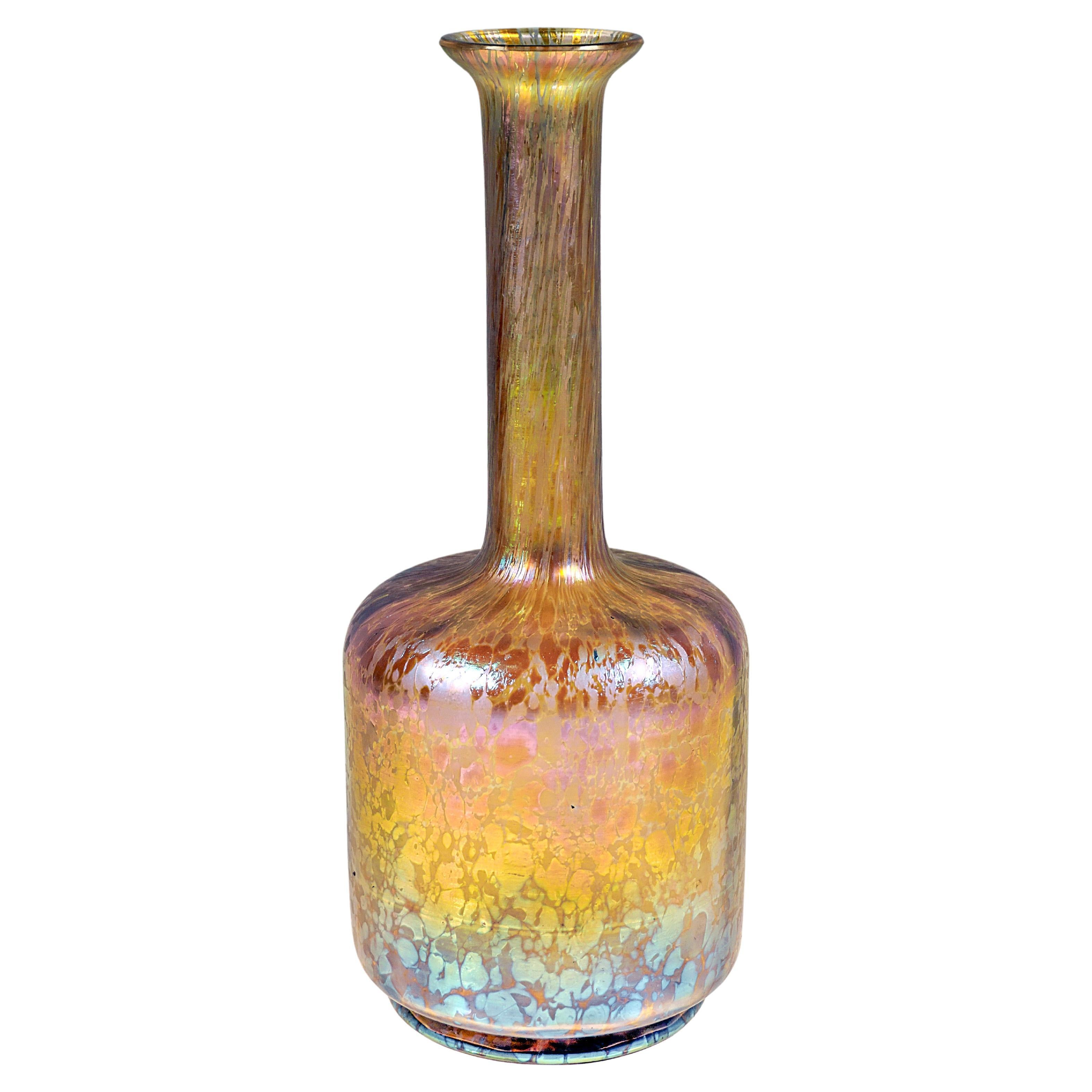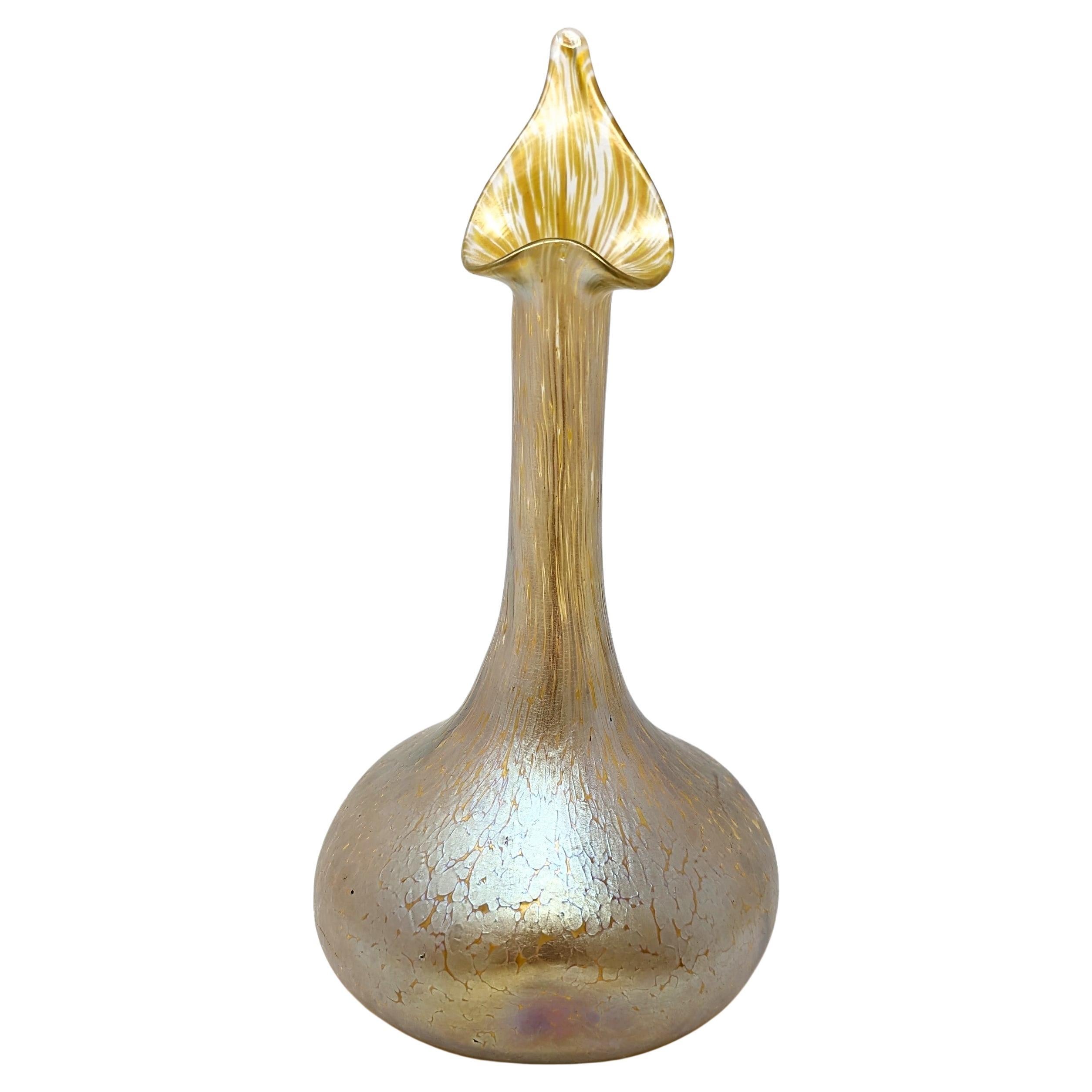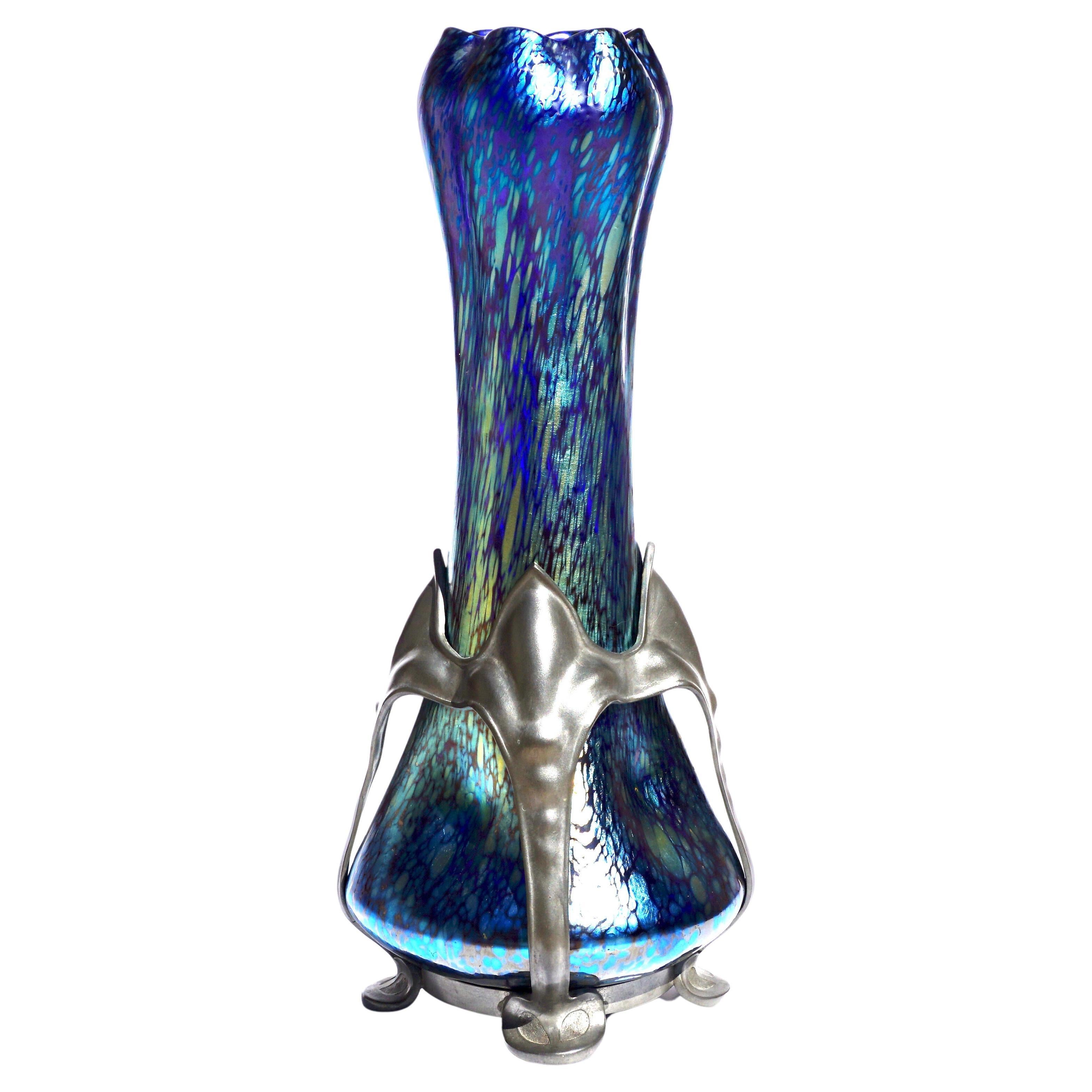Items Similar to Loetz Candia Papillon Art Nouveau Vase
Want more images or videos?
Request additional images or videos from the seller
1 of 8
Loetz Candia Papillon Art Nouveau Vase
About the Item
Loetz Iridescent and oil spot Flared Neck Art glass Floriform Goose neck vase.
Candia Papillon vase
Austria
Iridescent glass
Unsigned
Circa 1898 Art Nouveau
Measures: Height: 9.5 inches x 5.25 inches diameter
Condition: Excellent original condition.
In the Wottawattal of the Bohemian Forest was one of the oldest glass works, which was bought in 1850 by Johann Lötz,[2] the founder of the company, and former owner of glass factories in Deffernik, Hurkental, Annatal and Vogelsang.
In 1879 Max Ritter von Spaun, a grandson of Johann Lötz, took over the factory from his grandmother and continued to run it under the old company name, "Joh. Lötz Witwe".[3] The factory had previously been equipped with a significant grinding shop. It was here that heavily cut crystal and cut-through enameled flashing glass were manufactured. The company started to produce the colored glass in the 1860s.
Lötz'sche glass has always been a specialty because of its purity and fiery colors, and was initially purchased as raw glass by North Bohemian refineries, who refined the same through painting and grinding. Later, due to the high regard of the glass, the company started production of specialty luxury items. The company was the first to manufacture the so-called baroque glass—objects with applied glass decorations—in Austria. Sample warehouses were located in Vienna, Berlin, Hamburg, Paris, London, Brussels, Milan, and Madrid, which soon gave the products a worldwide reputation.
The glass artfully imitated all types of Onyx, Jasper, Carnelian, Malachite, Lapis, Inlaid glass, etc. The luxury glasses that emerged from the factory received the highest awards. In the anniversary exhibition in 1888, the "Kaiser Franz Josefs Vase", designed by Hofrat Storck and produced by the Lötz company in Grauonyx, was unveiled. It was the largest vase that had been blown from glass until then. Most of the world exhibitions were loaded with special products from the company and were given the highest awards, including the Prix de Progrès and Honorary Diploma Brussels 1888; and the Grand Prix Paris 1889; as well as honorary diplomas from Vienna, Munich, Antwerp, Chicago, and San Francisco.
Max Ritter von Spaun had received several awards for his services to the glass industry. In 1883 he received the high distinction of being allowed to carry the title kk priv. Glasfabrik and the imperial eagle in the shield and seal. He was also recognized in 1889 by the award of the Knight's Cross of the Order of Franz Josef; the Belgian Order of Leopold; and the Order of the French Legion of Honor.
Eduard Prochaska, with the company since 1880, served as director. The sons and grandsons of the workers employed in Joh. Lötz's glassworks were the tribe of the factory staff, a testament to the good understanding between the employer and the worker.
Similar to the glasses from Louis Comfort Tiffany, Loetz was able to produce colored glasses with high level of metallic iridescence. The company had contacts with other manufacturers such as J. & L. Lobmeyr and E. Bakalowits Söhne in Vienna and with the Argentor plants. Well-known artists with whom he worked were Josef Hoffmann, Koloman Moser, and the Wiener Werkstätte.[6] The peak of the cooperation happened after 1900. The company was represented and won awards at the Paris World's Fair, and in the Chicago and St. Louis fairs.
The outbreak of the First World War and the collapse of the monarchy brought difficult times for the company. The Second World War and the expulsion of the German-speaking population of Czechoslovakia, and thus a large part of the employees, meant the complete end of the company.
- Creator:Loetz Glass (Manufacturer)
- Dimensions:Height: 5.25 in (13.34 cm)Diameter: 9.5 in (24.13 cm)
- Style:Art Nouveau (Of the Period)
- Materials and Techniques:Art Glass,Fired
- Place of Origin:
- Period:
- Date of Manufacture:1898
- Condition:Wear consistent with age and use.
- Seller Location:Dallas, TX
- Reference Number:1stDibs: LU1774227475872

About the Seller
4.9
Gold Seller
These expertly vetted sellers are highly rated and consistently exceed customer expectations.
Established in 2000
1stDibs seller since 2015
402 sales on 1stDibs
Typical response time: 1 hour
- ShippingRetrieving quote...Ships From: Dallas, TX
- Return PolicyA return for this item may be initiated within 7 days of delivery.
More From This SellerView All
- Loetz Candia Papillon Three Handled VaseBy Loetz GlassLocated in Dallas, TXLoetz Candia Papillos three handled vase. Austria Circa 1910 Measures: Height: 5.75 inches Diameter: 5.5 inches Condition Excellent with no issues. AVANTIQUES is dedicated to providing an exclusive curated collection of Fine Arts, Paintings, Bronzes, Asian treasures, Art Glass and Antiques. Our inventory represents time-tested investment quality items with everlasting decorative beauty. We look forward to your business and appreciate any reasonable offers. All of our curated items...Category
Vintage 1910s Austrian Art Nouveau Vases
MaterialsArt Glass
- Loetz Cobalt Papillon Art Nouveau VaseBy Loetz GlassLocated in Dallas, TXThis Loetz vase in the Cobalt Papillon pattern has blue iridescent Papillon design covering the exterior of the vase. Vase is signed on the polished ...Category
Antique Early 1900s Austrian Art Nouveau Vases
MaterialsArt Glass
- Loetz Cobalt Papillon Art Nouveau VaseBy Loetz GlassLocated in Dallas, TXA Loetz Cobalt Papillon Art Glass and Pewter Art Nouveau Vase. Circa 1900 The shapely design with flared base having four evenly spaced indentations...Category
Antique Early 1900s Czech Art Nouveau Vases
MaterialsPewter
- Loetz Astraea Art Nouveau Glass VaseBy Loetz GlassLocated in Dallas, TXA large Loetz Astraea glass case Circa 1905 A lovely yellow and oil spot decor "Astraea" vase by Loetz. The glass vase is cylindrical in form with a three-lobed mouth. The backgroun...Category
Antique Early 1900s Czech Art Nouveau Vases
MaterialsArt Glass
- Loetz Silver Overlay Art Nouveau Vases PairBy Loetz GlassLocated in Dallas, TXLoetz Art Nouveau circa 1900 art glass vases with floral and decorative scroll Silver Overlay. (Pair) Larger: Corset form in iridescent gold glass decorated with scrolling silver overlay and a blank cartouche. Height: 5.25 X 2.75 Diameter Condition: Mint. Smaller: Bulbous smoke stack form in iridescent green-gold decorated with scrolling silver overlay flowers. Marked: Alvin pat 67 Height: 4.25 X 2,65 Diameter Condition: Mint AVANTIQUES is dedicated to providing an exclusive curated collection of Fine Arts, Paintings, Bronzes, Asian treasures, Art Glass and Antiques. Our inventory represents time-tested investment quality items with everlasting decorative beauty. We look forward to your business and appreciate any reasonable offers. All of our curated items are vetted and guaranteed authentic and as described. Avantiques only deals in original antiques and never reproductions. We stand behind our treasures with a full money back return if the items are not as described. In 1836, Johann Eisner established a glassworks in the Southern Bohemian town of Klostermühle, today part of the Czech Republic and called Klášterský Mlýn. His heirs sold the glassworks to Martin Schmid in 1849, and two years later Schmid sold it to Frank Gerstner, attorney-at-law, and his wife Susanne. Susanne was the widow (‘Witwe’ in German) of Johann Loetz, a glassmaker about whom we know very little. Gerstner transferred sole ownership to Susanne shortly before his death in 1855, and she successfully led and expanded the company during the subsequent 20 years, manufacturing mainly crystal, overlay and painted glass. In 1879, Susanne transferred the company – now called ‘Johann Loetz Witwe’ – to Maximilian von Spaun, the son of her daughter Karoline. One year later, von Spaun hired Eduard Prochaska and the two of them modernized the factory and introduced new, patented techniques and processes. The first fruits of this collaboration were exciting innovations in Historicism glass, including Intarsia and Octopus glass and the very popular marbled (‘marmorisierte’) glass which imitated semi-precious stones like red chalcedony, onyx and malachite. Success at exhibitions in Brussels, Munich and Vienna were crowned by awards at the Paris World’s Exposition in 1889. In 1897, von Spaun first saw Tiffany Favrile glass exhibited in Bohemia and Vienna, and this convinced him that the art nouveau style was also the way to go for Loetz Witwe. The next eight years were to be the most artistically significant and profitable period in the entire history of the company. The Art Nouveau Period –The glassworks created large numbers of its own new designs of iridescent, trailing art nouveau glass, sometimes in collaboration with well-known artists and designers like Marie Kirschner and Franz Hofstötter (aka Franz Hofstätter). The zenith of Loetz art nouveau glass was epitomized by the so-called Phänomen series of designs, much of it designed by Hofstötter, which won a Grand Prix (alongside Tiffany, Gallé, Daum and Lobmeyr) at the Paris World’s Exposition in 1900. The company’s success during this period had two prime drivers – the technical expertise of Prochaska and the business acumen of von Spaun. Loetz Witwe created many of its own designs, and also supplied glass commissioned by major customers like E. Bakolowits (Vienna) and Max Emanuel...Category
Antique Early 1900s Austrian Art Nouveau Vases
MaterialsArt Glass
- Loetz Glatt Bronze Three Handled Glass VaseBy Loetz GlassLocated in Dallas, TXLoetz Three Handle iridescent glass vase in the Glatt Bronze design, handles applied with raspberry prints. Height: 6.5 Inches. Diameter: 6 Inches Condition; Very good Johann Loetz W...Category
Antique Early 1900s Austrian Art Nouveau Vases
MaterialsArt Glass
You May Also Like
- Loetz Art Nouveau Vase, Decor Candia Papillon, Bohemia, Austria-Hungary 1898By Loetz GlassLocated in Vienna, ATFinest Bohemian Art Nouveau Glass Vase: Mould blown glass on flush stand, bulbous raised body fourfold extensively impressed, with short wide neck, lip rim formed into quatrefoil, cu...Category
Antique 1890s Austrian Art Nouveau Glass
MaterialsGlass
- Loetz Art Nouveau Vase, Decor Candia Papillon, Bohemia, Austria-Hungary 1898By Loetz GlassLocated in Vienna, ATFinest Bohemian Art Nouveau Glass Vase: Mould-blown glass vase, cylindrical lower body on a recessed, flush stand, long, slender neck with flared rim. Shape: Series I, Prod. nr. - P...Category
Antique 1890s Austrian Art Nouveau Glass
MaterialsGlass
- Antique Glass Vase Candia Papillon Loetz Witwe Bohemia Circa 1898 Art NouveauBy Loetz GlassLocated in Greer, SCExquisite antique Loetz Witwe glass vase titled "Candia Papillon" out of Bohemia, circa 1898. This eye catching work of art has exceptional iridescent coloration and has an extraordi...Category
Antique Late 19th Century Czech Art Nouveau Vases
MaterialsArt Glass
- Signed Loetz Candia Papillon Iridescent Vase, c1910By Loetz GlassLocated in Tunbridge Wells, GBSigned Loetz Candia Papillon Iridescent Vase, c1910 Additional information: Date : c1910 Origin : Austria Bowl Features : Applied butterflies on...Category
20th Century Austrian Art Nouveau Vases
MaterialsGlass
- A Very Tall Gold Loetz Candia Papillon Vase, c1910By Loetz GlassLocated in Tunbridge Wells, GBA Very Tall Gold Loetz Candia Papillon Vase, c1910 Additional information: Date : c1910 Origin : Klostermuhle, Bohemia, now the Czech Republic B...Category
20th Century Czech Art Nouveau Vases
MaterialsGlass, Art Glass, Blown Glass
- Loetz Art Nouveau Single Flower Vase, Phenomenon Gre Candia 6893, circa 1898By Loetz GlassLocated in Vienna, ATFinest Bohemian Art Nouveau glass vase: Mold-blown, disc-shaped body on a flush stand with raised, slender, trumpet-shaped, widening neck, flatened, 10-times wave-shaped mouth rim, ...Category
Antique 1890s Austrian Art Nouveau Glass
MaterialsGlass
Recently Viewed
View AllMore Ways To Browse
The Antique Company
Antique Fire Items
Large Antique Glass Vases
Large Antique Glass Vase
Glass Art Plant
Art Glass Seal
Art Nouveau Service
Antique Iridescent Glass
Iridescent Antique Glass
French Enamel Glass Vase
Antique Cut Glass Vase
Types Of Antique Vases
Serve Vases
Nouveau Fire
Art Nouveau Fire
Art Nouveau Vases Large
Iridescent Art Nouveau
Old World Vases





